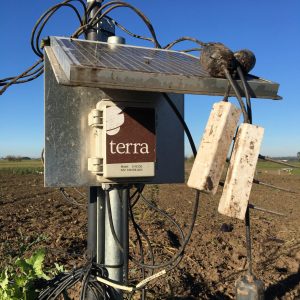Investigating the relationship between compost and soil moisture
In this article, Virginia Brunton and Solomon Wadani from MRA Consulting Group discuss a project focusing on the impact that compost can have on water retention in vegetable crops, using a Western Sydney-based vegetable trial site as an example.
Vegetable production is highly water intensive as crops always require adequate water resources. Maintaining soil moisture under an increasingly variable and extreme climate is predicted to become even more difficult than it is at present. After the recent drought in many parts of Australia, growers are looking for more water security. This project investigates the ability of compost to increase the amount of water available to vegetable crops and retain it for longer.
Compost applications have been shown to increase soil water retention, and therefore can be used as effective drought amelioration by increasing the amount of water held in a soil.
Over the course of two growing seasons (winter and summer), Agnov8 trialled the effect that compost had on soil water retention. This was undertaken in partnership with MRA Consulting Group and the New South Wales-based Greater Sydney Local Lands Services (GS LLS), and took place on the GS LLS demonstration farm in Richmond Lowlands, Western Sydney. It used compost made from kerbside garden organics.

Collecting data
Using Agnov8’s innovative remote irrigation monitoring technology, this project aimed to demonstrate to vegetable growers that compost can improve soil-plant-water relations and build awareness about compost as a means of retaining water in soils.
The Agnov8 Omne environmental sensors (see Figure 1) are automatous wireless units powered by solar panels, which communicate to a cloud by utilising an aggregation unit. With a range of up to three kilometres, this technology is applicable for use in broadacre properties. The sensors recorded continuous data on soil growing properties such as volumetric water content (VWC), electrical conductivity (EC) and soil temperature. The data, accessible on a live dashboard, also incorporated weather station readings including rainfall, temperature, humidity, and solar radiation.
The trial was established using five winter crops; three cabbage varieties, cauliflower and broccoli and a second series using four summer crops; two eggplant varieties, capsicum, and sweet corn.
There were three treatments tested in the trial; a Control with no compost, Treatment 1 – compost applied at 10 wet tonnes per hectare (wt/ha), and Treatment 2 – 20wt/ha applied. Soil monitoring occurred at 10cm, 20cm and 30cm depths.
Yield data at harvest was obtained and observational pest and disease monitoring was also conducted.

Trial results
Analysis of the VWC data indicates a correlation between compost rate and soil water retention. Treatment 2 (20wt/ha) retained more soil water than the control plot, which had no compost (see Figure 2).
There was no significant difference between treatments for crop yields, except for the midnight eggplant variety, which yielded a 60 per cent gain in average fruit weight for Treatment 2 when compared to Control.
Visual inspection for pests and diseases showed no significant difference between treatments. Figure 3 shows clear differences in crop condition in the peak of summer. These pictures were taken in mid-January on one of the hottest days of summer (>350C). There is a clear difference in the plant response to extreme environmental conditions, with compost ameliorated crops wilting less under these conditions.
This trial demonstrated that compost applied to land at 20wt/ha can improve soil water retention, and therefore improve the growing conditions of a soil. This allows growers to save on water use without impacting crop yield.
Under a changing climate, it is expected that growing conditions for vegetable production will become increasingly more variable. Improving the soil water holding capacity can help to alleviate uncertainties with water security. Adopting compost made from recycled kerbside organics as a soil amendment can prove economically beneficial to farmers, while ensuring crop success.
The project team is hoping to continue the trial to further demonstrate the impact of compost and consolidate the current findings.

Find out more
Please contact Virginia Brunton at organics@mraconsulting.com.au.
This project was funded by the NSW Department of Planning, Industry and Environment as part of its Organics Market Development Program.
This article has appeared in Vegetables Australia – Summer 2020/21. To read the full publication, please click here.

